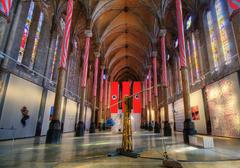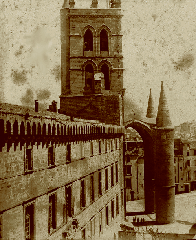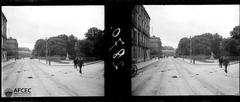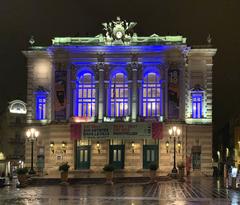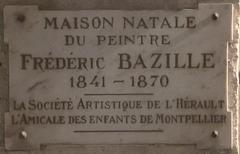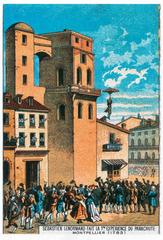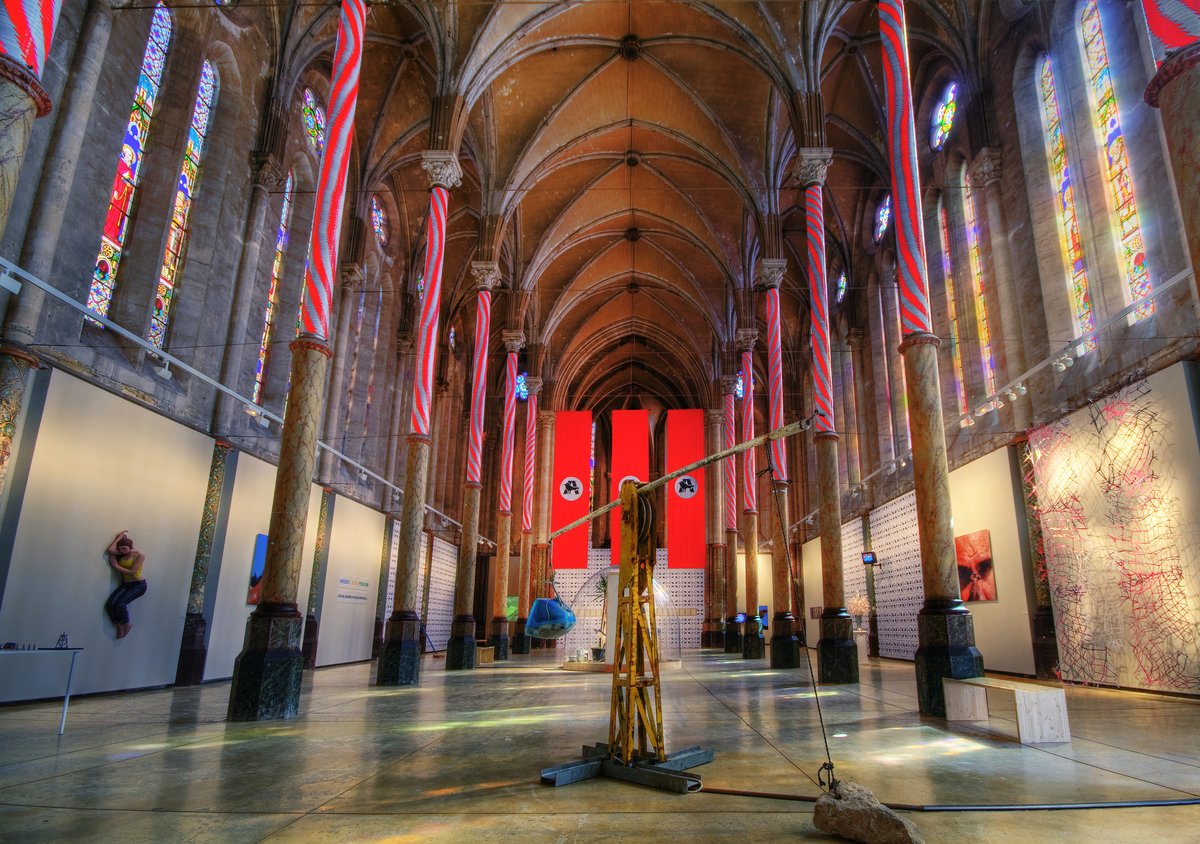
Carré Sainte-Anne Montpellier: Visiting Hours, Tickets, and 2025 Travel Guide
Date: 14/06/2025
Introduction: The Historical and Cultural Significance of Carré Sainte-Anne
Nestled in the heart of Montpellier’s Écusson district, Carré Sainte-Anne is a striking testament to the city’s layered history and thriving contemporary art scene. Originally built between 1866 and 1872 as the Église Sainte-Anne, this neo-Gothic masterpiece was designed by Jules Cassan and is renowned for its soaring octagonal bell tower, intricate stained glass, and monumental rose window. Over time, the building transitioned from a place of worship to a vibrant cultural venue, reflecting Montpellier’s ongoing dialogue between heritage preservation and modern creativity.
After a significant closure period beginning in 2017 due to structural concerns—primarily involving the massive bell tower—Carré Sainte-Anne underwent a meticulous restoration, culminating in its highly anticipated reopening in June 2025. The restoration not only preserved the building’s historic character but also enhanced accessibility and visitor facilities, setting the stage for a new era as a premier destination for contemporary art. The 2025 reopening will be inaugurated by a major exhibition from internationally acclaimed artist JR, inviting the public to participate in a communal artwork and reconnect with this emblematic site (Montpellier Tourisme; En Commun Montpellier).
Whether you are a history enthusiast, art lover, or a traveler seeking a unique cultural experience, Carré Sainte-Anne offers a compelling journey through time and creativity in the heart of Montpellier (montpellier.fr; midilibre.fr).
Table of Contents
- Historical Origins and Architectural Features
- Transformation from Church to Contemporary Art Space
- Restoration and 2025 Reopening
- Cultural Significance and Community Role
- Visitor Information: Hours, Tickets, and Accessibility
- Practical Travel Tips
- Visuals and Media Resources
- Related Sites in Montpellier
- Frequently Asked Questions (FAQ)
- Conclusion and Further Reading
Historical Origins and Architectural Features
Carré Sainte-Anne originated as the Église Sainte-Anne, constructed between 1866 and 1872 to serve Montpellier’s growing population. Architect Jules Cassan’s design is a quintessential example of the 19th-century neo-Gothic revival, featuring a 68-meter octagonal bell tower—the tallest in the city’s historic center. The church’s pointed arches, ribbed vaults, and grand rose window continue to dominate the local skyline and offer an impressive backdrop for contemporary exhibitions (ToutMontpellier.fr).
Inside, the vast nave (over 600 m²) is illuminated by original stained glass, creating a dramatic play of light and shadow that enhances the display of modern artworks. The church’s historical significance is further enriched by recent archaeological discoveries during restoration, including a stone sarcophagus and evidence of earlier structures beneath the current building (France 3 Régions).
Transformation from Church to Contemporary Art Space
Following desacralization in the late 1980s, the city of Montpellier repurposed the former church as a contemporary art venue, inaugurating Carré Sainte-Anne in 1991. The transformation involved adapting the nave and chapels into versatile exhibition spaces while maintaining the integrity of the neo-Gothic architecture (Montpellier Tourisme).
Since its conversion, Carré Sainte-Anne has hosted major exhibitions by internationally renowned artists such as Joana Vasconcelos, Chiharu Shiota, Gérard Garouste, Hervé Di Rosa, and Jean-Michel Othoniel. Its programming fosters artistic innovation and community engagement, often featuring participatory projects and collaborations with local schools and artisans (artsupp.com).
Restoration and 2025 Reopening
Structural Challenges and Restoration Efforts
In 2017, Carré Sainte-Anne closed due to critical structural issues, especially differential settlement between the massive bell tower and the nave caused by clay soil and historic construction methods (encommun.montpellier.fr). Over €4.7 million was invested in a comprehensive restoration (2021–2025), which included:
- Reinforcing the bell tower and nave columns with tension rods and new stone blocks.
- Restoring the roof, facades, and stained glass to prevent water infiltration and enhance longevity.
- Upgrading accessibility and visitor facilities with new entrances, ramps, and climate control.
- Integrating smart structural monitoring to ensure ongoing safety (encommun.montpellier.fr; midilibre.fr).
Reopening Highlights
The grand reopening in June 2025 is celebrated with a participatory installation by JR, inviting visitors to contribute handprints to a monumental artwork symbolizing collective memory (France 3 Régions). The venue will continue to host three major exhibitions annually, maintaining its role as a flagship of contemporary art in southern France (midilibre.fr).
Cultural Significance and Community Role
Carré Sainte-Anne exemplifies Montpellier’s commitment to preserving and activating its historic sites. Its location in the lively Écusson district, surrounded by cafes and other landmarks, makes it a focal point for both locals and tourists. Free admission and inclusive programming ensure that art and heritage are accessible to all, reinforcing the venue’s role as a hub of cultural exchange and urban vitality (montpellier.fr).
The building’s transformation from sacred space to contemporary gallery reflects broader trends in adaptive reuse, where historical sites are reimagined to serve evolving civic and cultural needs (Secret Attractions).
Visitor Information: Hours, Tickets, and Accessibility
Location:
2 Rue Philippy, 34000 Montpellier, France
Opening Hours:
- Tuesday to Sunday: 10:00–13:00 and 14:00–18:00 (winter); 11:00–13:00 and 14:00–19:00 (summer)
- Closed Mondays and certain public holidays
- Confirm current hours before visiting: Montpellier Tourism Exhibitions Calendar
Admission and Tickets:
- Entry is typically free, supporting broad access to art and culture
- Special exhibitions or workshops may require advance booking or a nominal fee
Guided Tours and Events:
- Free guided tours are offered during reopening periods and special events (booking recommended)
- Workshops and lectures for all ages foster community engagement (France 3 Régions)
Accessibility:
- The venue is accessible to visitors with reduced mobility
- Level flooring, ramps, and clear signage throughout
- Staff assistance available if needed
Practical Travel Tips
- By Tram: Line 1 (green) to ‘Comédie’ stop, 10-minute walk along Rue de la République to Rue Philippy (Evendo)
- By Car: Exit A9 at Junction 29, follow for Montpellier Centre, parking nearby (€1–€2/hour)
- On Foot: 700 meters east from Place de la Comédie
- Facilities: On-site restrooms; cafés and restaurants nearby
- Photography: Allowed for personal use unless otherwise indicated during certain exhibitions
Visuals and Media Resources
- High-quality images and virtual tours are available on official tourism sites
- Alt tags (e.g., “Carré Sainte-Anne visiting hours,” “Montpellier historical sites”) improve accessibility and SEO
- Explore Montpellier’s Historical Sites
Related Sites in Montpellier
- Musée Fabre: Fine arts museum
- Saint-Pierre Cathedral: Neo-Gothic landmark
- La Panacée: Contemporary art center
Frequently Asked Questions (FAQ)
Q: What are the visiting hours of Carré Sainte-Anne?
A: Typically Tuesday–Sunday, 10:00–13:00 and 14:00–18:00 (winter), 11:00–13:00 and 14:00–19:00 (summer). Closed Mondays and public holidays.
Q: Is there an admission fee or tickets required?
A: Admission is generally free; some special programs or workshops may require reservations.
Q: Are guided tours available?
A: Yes, free guided tours during reopening and special events; booking recommended.
Q: Is the venue accessible for visitors with reduced mobility?
A: Yes, recent renovations have improved accessibility.
Q: Can I take photographs during my visit?
A: Photography is allowed for personal use unless restricted during specific exhibitions.
Q: How do I get to Carré Sainte-Anne?
A: Located in the Écusson district, accessible by tram (line 1), bus, car, and on foot.
Conclusion and Further Reading
Carré Sainte-Anne is a unique convergence of Montpellier’s historical heritage and contemporary artistic innovation. The 2025 reopening, highlighted by participatory art and inclusive programming, reaffirms its status as a cornerstone of the city’s cultural landscape. With enhanced accessibility, free admission, and a vibrant calendar of events, Carré Sainte-Anne promises an inspiring visit for all who seek to explore Montpellier’s past and present.
Plan your visit today, consult the latest information online, and enrich your experience with nearby sites such as Musée Fabre and the Promenade du Peyrou. For personalized guides and real-time updates, consider downloading the Audiala app and following Montpellier’s cultural venues on social media.
References and Further Reading
- Carré Sainte-Anne Montpellier: Visiting Hours, Tickets, and Cultural Insights (Montpellier Tourisme)
- Reopening of Carré Sainte-Anne, 2025 (En Commun Montpellier)
- Carré Sainte-Anne Restoration and Cultural Programming (Montpellier.fr)
- 2025 Cultural Events and Restoration (Midi Libre)
- Carré Sainte-Anne Closure and Structural Challenges (En Commun Montpellier)
- ToutMontpellier.fr
- France 3 Régions
- artsupp.com
- Secret Attractions
- Evendo
- blog.ruedesvignerons.com
- montpellier.evous.fr
